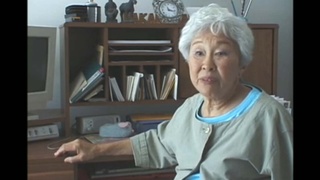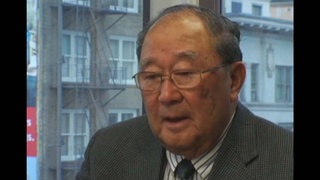Interviews
Proud to be a Japanese desecendant (Spanish)
(Spanish) I left Japan on the Buenos Aires Maru. In practical terms, it [the ship] was built to be a battleship, I don’t know. But the crew, the majority had been to war. And before arriving at Yokohama because first we arrived at Yokohama and then at Kobe, I disembarked at Kobe. But before arriving at Yokohama, everyday, everyday, we did as one says in nihongo (Japanese), “donchan sawagi,” because we were at war, you know, as they celebrated with flags and a bunch of things. When we arrived at Yokohoma there was a big celebration, a welcoming [celebration], because already everything had been prepared. For that [reason] I say that I saw the best part of Nihon (Japan) before, during, and after the war, and over time, like twenty years or more…I saw four faces of Nihon. For that reason, I can say that I am lucky to have seen [every facet] of Japan, the worst, the best, the good and the bad, and much better. I saw it all. I don’t say this to everybody, of course, one has it inside, but it is a pride that I have in the strength of the nihonjin (Japanese). There is much that doesn’t bother them [the Japanese], but I feel it.
Date: September 18, 2006
Location: Buenos Aires, Argentina
Interviewer: Takeshi Nishimura, Ricardo Hokama
Contributed by: Centro Nikkei Argentino
Explore More Videos

Importance of education in achieving redress for incarceration
(1919-2014) Activist for civil rights and redress for World War II incarceration of Japanese Americans.

Having patience in Japan, being both
(b.1964) California-born business woman in Japan. A successor of her late grandmother, who started a beauty business in Japan.

Preserving traditional Japanese culture
(b.1964) California-born business woman in Japan. A successor of her late grandmother, who started a beauty business in Japan.

Her experience as a Japanese-American schoolchild in Oceanside, California, after the bombing of Pearl Harbor
(1924-2018) Artist and playwright.

Working at the magazine
(b.1948) Nikkei from Southern California living in Japan.

The privations of living in post-war Japan, 1952
(b.1925) Nisei of Okinawan descent. Had a 38-year career in Japan as a baseball player, coach, scout, and manager.

Loss of happy-go-lucky adolescence in Puyallup Assembly Center
(b. 1923) Nisei from Washington. Resisted draft during WWII.

Memories of dusty conditions at Minidoka incarceration camp
(b. 1923) Nisei from Washington. Resisted draft during WWII.

Making the decision to resist the draft
(b. 1923) Nisei from Washington. Resisted draft during WWII.

Discharged from the U.S. Army after Pearl Harbor
(b. 1918) Founder Azumano Travel

Reaction to a 1942 speech by Mike Masaoka, Japanese American Citizen League's National Secretary
(1915 - 2011) Nisei florist who resettled in New York City after WW II. Active in Japanese American civil rights movement

Death of sister in October 1942
(1915 - 2011) Nisei florist who resettled in New York City after WW II. Active in Japanese American civil rights movement

First impression of New York City during war time
(1915 - 2011) Nisei florist who resettled in New York City after WW II. Active in Japanese American civil rights movement

Neighbors' sympathy after Pearl Harbor
(1915 - 2011) Nisei florist who resettled in New York City after WW II. Active in Japanese American civil rights movement

Reaction of Japanese American community toward draft resistance stance
(b. 1925) Draft resister
